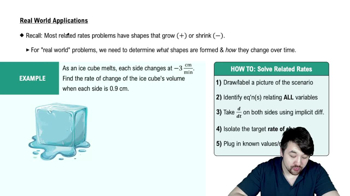Table of contents
- 0. Functions7h 52m
- Introduction to Functions16m
- Piecewise Functions10m
- Properties of Functions9m
- Common Functions1h 8m
- Transformations5m
- Combining Functions27m
- Exponent rules32m
- Exponential Functions28m
- Logarithmic Functions24m
- Properties of Logarithms34m
- Exponential & Logarithmic Equations35m
- Introduction to Trigonometric Functions38m
- Graphs of Trigonometric Functions44m
- Trigonometric Identities47m
- Inverse Trigonometric Functions48m
- 1. Limits and Continuity2h 2m
- 2. Intro to Derivatives1h 33m
- 3. Techniques of Differentiation3h 18m
- 4. Applications of Derivatives2h 38m
- 5. Graphical Applications of Derivatives6h 2m
- 6. Derivatives of Inverse, Exponential, & Logarithmic Functions2h 37m
- 7. Antiderivatives & Indefinite Integrals1h 26m
- 8. Definite Integrals4h 44m
- 9. Graphical Applications of Integrals2h 27m
- 10. Physics Applications of Integrals 2h 22m
4. Applications of Derivatives
Related Rates
Problem 3.6.29a
Textbook Question
Consider the following cost functions.
a. Find the average cost and marginal cost functions.
C(x) = 1000+0.1x, 0≤x≤5000, a=2000
 Verified step by step guidance
Verified step by step guidance1
To find the average cost function, divide the total cost function C(x) by the number of units x. The average cost function A(x) is given by A(x) = C(x) / x.
Substitute the given cost function C(x) = 1000 + 0.1x into the average cost formula: A(x) = (1000 + 0.1x) / x.
Simplify the expression for A(x) to get A(x) = 1000/x + 0.1.
To find the marginal cost function, take the derivative of the total cost function C(x) with respect to x. The marginal cost function MC(x) is given by MC(x) = dC(x)/dx.
Differentiate C(x) = 1000 + 0.1x with respect to x. Since the derivative of a constant is 0 and the derivative of 0.1x is 0.1, the marginal cost function MC(x) = 0.1.
 Verified video answer for a similar problem:
Verified video answer for a similar problem:This video solution was recommended by our tutors as helpful for the problem above
Video duration:
4mPlay a video:
Was this helpful?
Key Concepts
Here are the essential concepts you must grasp in order to answer the question correctly.
Average Cost Function
The average cost function, denoted as AC(x), represents the total cost C(x) divided by the quantity produced x. It provides insight into the cost per unit of production, helping businesses determine pricing strategies. For the given cost function C(x) = 1000 + 0.1x, the average cost can be calculated as AC(x) = C(x)/x, which simplifies to (1000/x) + 0.1.
Recommended video:

Average Value of a Function
Marginal Cost Function
The marginal cost function, denoted as MC(x), measures the additional cost incurred by producing one more unit of output. It is derived from the derivative of the total cost function C(x) with respect to x. For the cost function C(x) = 1000 + 0.1x, the marginal cost is found by calculating MC(x) = dC/dx, which results in a constant value of 0.1, indicating that each additional unit costs 0.1.
Recommended video:

Properties of Functions
Cost Function
A cost function describes the relationship between the quantity of output produced and the total cost incurred in production. It typically includes fixed costs, which do not change with output, and variable costs, which do. In the provided function C(x) = 1000 + 0.1x, the fixed cost is 1000, while the variable cost is represented by the term 0.1x, indicating that costs increase linearly with production.
Recommended video:

Properties of Functions
Related Videos
Related Practice






